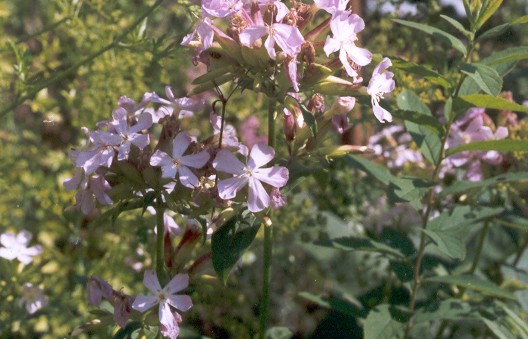
Saponaria officinalis (L)
Synonyms and Common names: Bouncing bet, sweet betty, wild sweet william, bruisewort, dog cloves, old maidsí pink, soap root, latherwort, fullerís herb, fullerís grass, foam dock, gill-run-by-the-street saponary, lady-by-the-gate, crow soap, hedge pink, farewell summer
French = Saponaire, German = Seifenkraut, Spanish = Saponella, Italian = Saponaria
Order: Caryophyllaceae

Description: Saponaria is a straggling, hairless perennial herb, growing up to 80cm. The jointed, creeping, branched, cylindrical rhizome gives rise to numerous erect, glabrous, sterile or flower-bearing stems. The simple non-flowering stems have oval to elongated and pointed opposite leaves, the lower ones on short petioles and the upper ones sessile. The flower-bearing stems are sparsely branched and leafy in the lower part terminating in rich panicles of flowers. The large flowers, which appear from June to September, are in a compact inflorescence; the cylindrical calyx is often reddish, the petals pale pink. There are ten stamens and the fruit is an oval capsule. Saponaria prefers damp sandy soil, hedgerows, and cultivated or disturbed ground. It can tolerate drought. It grows from Belgium, north Germany and central Russia southwards.
Parts used: rhizome and roots; the aerial parts to a lesser extent
Collection: The rhizome is collected and dried in September and October, the aerial parts during the flowering period.
Constituents: About 5% saponins, resin, mucilage, and a small amount of volatile oil
Actions: expectorant, alterative, laxative, cholagogue, detergent, purgative
Indications: skin disease, arthritic conditions
Therapeutics and Pharmacology: The medicinal properties of Saponaria are due to its hormone-like saponins. Their strongly irritant action in the gut stimulates the cough reflex and increases the production of a more fluid mucus within the respiratory tract. It has been used in the treatment of dry cough, bronchitis and some cases of asthma.
The plant has a traditional reputation for both the internal and external treatment of skin conditions such as eczema, psoriasis, acne and boils. Its use as a remedy for gout and rheumatism is probably due to the anti-inflammatory action of the saponins. The root is also said to encourage bile flow, and is reported to have an effect on gallstones. It is laxative in quite small doses.
Caution: Soapwort is purgative and mildly poisonous in large doses, and should only be used as prescribed by a qualified practitioner. Long-term use may cause gastric irritation.
Preparation and Dosage: Dried herb: Soak 4 tablespoonfuls in a litre of cold water for five hours, then bring to the boil and simmer for 10 minutes. Drink a small glassful three times a day.
Additional Comments: Soapwort has been used in the past as a soap substitute and to produce a head on beer. Textile restorers use Saponaria which has been boiled in lime-free water to clean and revitalise old, fragile fabrics, and it may also be used as a gentle wash for damaged hair and sensitive skin. Soapwort is still cultivated for washing woollens in the Middle East. In the Swiss Alps, sheep used to be washed with it before they were shorn.
An old gypsy remedy was to apply a decoction of the root to a bruise or black eye to quickly get rid of the discoloration. The early American settlers used it as a wash to counter poison ivy rash. The eighteenth century Dutch physician Boerhaeve recommended the plant as a treatment for jaundice. Mrs. Grieve cites its use in venereal complaints, especially where the use of mercury had failed, and as a remedy for the cutaneous troubles resulting from syphilis. In India, the rhizome is used as a galactagogue. The flowers are sometimes added to salads or dried for inclusion in pot pourri.
Bibliography
Bartram, T. 1995 Encyclopaedia of Herbal Medicine, 1st edn., Grace Publishers, Bournemouth.
Bremness, L. 1994 Herbs, Dorling Kindersley Eyewitness Handbook, London.
Chevallier, A. 1996 The Encyclopaedia of Medicinal Plants, Dorling Kindersley, London.
Grieve, M. 1931 A Modern Herbal, (ed. C.F. Leyel 1985), London.
Grigson, G. 1996 (2nd.edn.) The Englishmanís Flora, Helicon Publishing, Oxford.
Hoffmann, D. 1990 The New Holistic Herbal, Second Edition, Element, Shaftesbury.
Lust, J. 1990 The Herb Book, Bantam, London.
Mabey, R. (ed.) 1991 The Complete New Herbal, Penguin, London.
Mills, S.Y. 1993 The Essential Book of Herbal Medicine, Penguin, London (First published in 1991 as Out of the Earth, Arkana).
Press, B. & Gibbons, B. 1993 Wild Flowers of Britain and Europe: Photographic Field Guide, New Holland Publishers, London.
Prihoda, A. 1989 The Healing Powers of Nature, Octopus, London.
Vickery, R. 1995 A Dictionary of Plant Lore, Oxford University Press.
Weiss, R.F. 1991 Herbal Medicine, Beaconsfield Arcanum, Beaconsfield.
Wren, R.C. 1988 Potter's New Cyclopaedia of Botanical Drugs and Preparations, C.W.Daniel, Saffron Walden.










